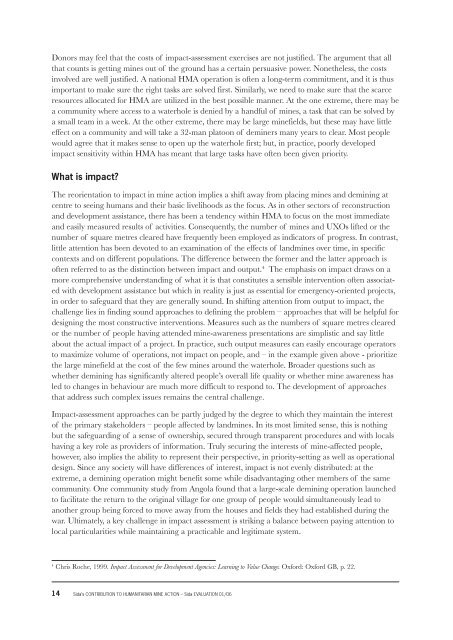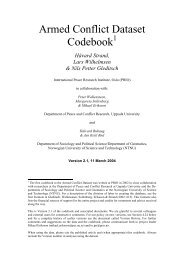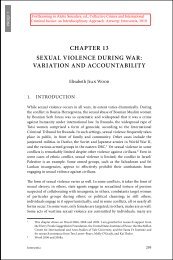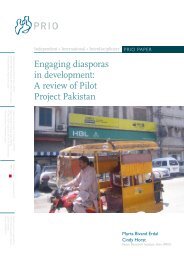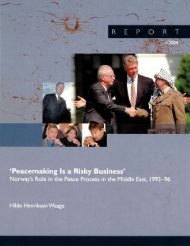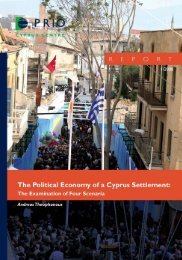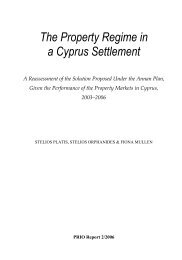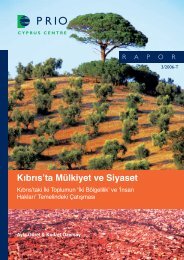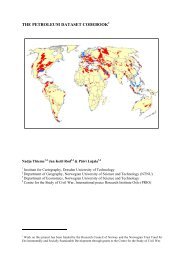Donors may feel that the costs of impact-assessment exercises are not justified. The argument that allthat counts is getting mines out of the ground has a certain persuasive power. Nonetheless, the costsinvolved are well justified. A national HMA operation is often a long-term commitment, and it is thusimportant <strong>to</strong> make sure the right tasks are solved first. Similarly, we need <strong>to</strong> make sure that the scarceresources allocated for HMA are utilized in the best possible manner. At the one extreme, there may bea community where access <strong>to</strong> a waterhole is denied by a handful of mines, a task that can be solved bya small team in a week. At the other extreme, there may be large minefields, but these may have littleeffect on a community and will take a 32-man pla<strong>to</strong>on of deminers many years <strong>to</strong> clear. Most peoplewould agree that it makes sense <strong>to</strong> open up the waterhole first; but, in practice, poorly developedimpact sensitivity within HMA has meant that large tasks have often been given priority.What is impact?The reorientation <strong>to</strong> impact in mine action implies a shift away from placing mines and demining atcentre <strong>to</strong> seeing humans and their basic livelihoods as the focus. As in other sec<strong>to</strong>rs of reconstructionand development assistance, there has been a tendency within HMA <strong>to</strong> focus on the most immediateand easily measured results of activities. Consequently, the number of mines and UXOs lifted or thenumber of square metres cleared have frequently been employed as indica<strong>to</strong>rs of progress. In contrast,little attention has been devoted <strong>to</strong> an examination of the effects of landmines over time, in specificcontexts and on different populations. The difference between the former and the latter approach isoften referred <strong>to</strong> as the distinction between impact and output. 4 The emphasis on impact draws on amore comprehensive understanding of what it is that constitutes a sensible intervention often associatedwith development assistance but which in reality is just as essential for emergency-oriented projects,in order <strong>to</strong> safeguard that they are generally sound. In shifting attention from output <strong>to</strong> impact, thechallenge lies in finding sound approaches <strong>to</strong> defining the problem – approaches that will be helpful fordesigning the most constructive interventions. Measures such as the numbers of square metres clearedor the number of people having attended mine-awareness presentations are simplistic and say littleabout the actual impact of a project. In practice, such output measures can easily encourage opera<strong>to</strong>rs<strong>to</strong> maximize volume of operations, not impact on people, and – in the example given above - prioritizethe large minefield at the cost of the few mines around the waterhole. Broader questions such aswhether demining has significantly altered people’s overall life quality or whether mine awareness hasled <strong>to</strong> changes in behaviour are much more difficult <strong>to</strong> respond <strong>to</strong>. The development of approachesthat address such complex issues remains the central challenge.Impact-assessment approaches can be partly judged by the degree <strong>to</strong> which they maintain the interes<strong>to</strong>f the primary stakeholders – people affected by landmines. In its most limited sense, this is nothingbut the safeguarding of a sense of ownership, secured through transparent procedures and with localshaving a key role as providers of information. Truly securing the interests of mine-affected people,however, also implies the ability <strong>to</strong> represent their perspective, in priority-setting as well as operationaldesign. Since any society will have differences of interest, impact is not evenly distributed: at theextreme, a demining operation might benefit some while disadvantaging other members of the samecommunity. One community study from Angola found that a large-scale demining operation launched<strong>to</strong> facilitate the return <strong>to</strong> the original village for one group of people would simultaneously lead <strong>to</strong>another group being forced <strong>to</strong> move away from the houses and fields they had established during thewar. Ultimately, a key challenge in impact assessment is striking a balance between paying attention <strong>to</strong>local particularities while maintaining a practicable and legitimate system.4Chris Roche, 1999. Impact Assessment for Development Agencies: Learning <strong>to</strong> Value Change. Oxford: Oxford GB, p. 22.14 Sida’s CONTRIBUTION TO HUMANITARIAN MINE ACTION – Sida EVALUATION 01/06
Impact can also be unders<strong>to</strong>od in terms of constraints. HMA always takes place in difficult environments,where a number of contextual fac<strong>to</strong>rs serve as constraints on the freedom of choice for animplementing body. The most important contextual fac<strong>to</strong>rs that apply have been discussed in theintroduction. Sensible priorities cannot be made without an appreciation of the constraints that applyin any given situation. Yet, it is also important <strong>to</strong> realize that constraints are not fixed entities, but arerather fac<strong>to</strong>rs which agencies can either affect or adapt <strong>to</strong>. One example of a key constraint is theavailability of funding. Some donors tie funding <strong>to</strong> particular projects or <strong>to</strong> particular geographic areas.Effectively, an implementing body is blocked from setting priorities based on it own assessments ofimpact. More generally, HMA ac<strong>to</strong>rs, in the absence of assessments of impact, have tended <strong>to</strong> giveprominence <strong>to</strong> constraints when establishing priorities.Situating impact assessmentAt an overall level, HMA is implemented at different stages of the reconstruction process. At the oneextreme, there may be an emergency stage, with an emphasis on short-term priorities. At the otherend, there is a development-oriented stage, where longer-term priorities are dominant. It can beargued that, at the emergency end, key priorities are more easily identified, and reducing accidents willalways be important. Furthermore, it will often be the case that certain high-priority tasks, such asreopening key transport routes or clearing areas for the resettlement of returnees, will stand out asobvious priorities. As one moves from the emergency <strong>to</strong>wards the development-oriented stage, establishingpriorities becomes more complex and requires more sophisticated approaches. Nonetheless, itis important that the launch of emergency responses are paralleled with a systematic effort <strong>to</strong> build upthe knowledge required <strong>to</strong> guide sensible priority-setting in the mid- <strong>to</strong> long-term. Too often, when asituation is defined as an emergency, it serves as an excuse for launching short-sighted operations, eventhough consideration of the broader and more long-term implications of an intervention is no lessimportant in an emergency situation. 5As one moves from emergency <strong>to</strong> development stages, it will also be the case that tasks that have animpact at the regional or national level, such as the reopening of key infrastructure, have been dealtwith. Hence, the focus will increasingly turn <strong>to</strong>wards projects where the major impact is exclusively atthe local level. In emergency-oriented tasks, it is often a problem that one is preoccupied with impact atregional or national levels only, while neglecting the impact on the community that hosts the operation.In one example from Mozambique, the local population had very little information about a majordemining exercise in their neighbourhood that was aimed at res<strong>to</strong>ring access <strong>to</strong> a central water pipeline.6 In the report from which the last example was taken, it is argued that micro-level impact exists inall macro-level tasks that take place in populated areas and that all agencies should take seriously thechallenge of maximizing impact at multiple levels.For impact assessment <strong>to</strong> contribute <strong>to</strong> a thorough improvement of HMA practice, it must be integratedas a <strong>to</strong>ol in the planning and implementation phases of projects. In the new UN International <strong>Mine</strong><strong>Action</strong> Standards (IMAS) which are currently in progress, four kinds of surveys will be included:general, impact, technical and the hand-over documentation. 7 The three first kinds of survey are allconducted prior <strong>to</strong> operations. Whereas the international standards are modified for both general andtechnical surveys, it is the standardization of the impact survey that5Additionally, it is often true that what is at first seen as an emergency requires a long-term response. This is indeed the casewith HMA. Most cases that have a dramatic mine problem that can be solved within a short time frame will also have a moreenduring mine problem of a less dramatic character that will require a long-term, sustainable response.6Ananda S. Millard & Kristian Berg Harpviken, 2000. Reassessing the Impact of <strong>Humanitarian</strong> <strong>Mine</strong> <strong>Action</strong>: Illustrations fromMozambique, PRIO Report 1/2000. Oslo: PRIO,Chapter 7.7The new standards exist in draft versions; most of them are available at http://www.mineclearancestandards.org/revised.htmSida’s CONTRIBUTION TO HUMANITARIAN MINE ACTION – Sida EVALUATION 01/06 15
- Page 4: This report is part of Sida Evaluat
- Page 9 and 10: MDDMEDDSMGMMLSWMoPHMOUMPLANATONDING
- Page 12 and 13: the conclusions of this report is t
- Page 14 and 15: A prime concern with Mine Action Ce
- Page 16 and 17: 3. The coordination of mine action,
- Page 18 and 19: an needs and the needs of victims o
- Page 20 and 21: At the same time as Sida has been o
- Page 22 and 23: er, throughout the data collection,
- Page 26 and 27: is genuinely new. 8 At an overall l
- Page 28 and 29: The first attempt to apply a form o
- Page 30 and 31: standard for basic impact surveys.
- Page 32 and 33: Community studiesCommunity studies
- Page 34 and 35: and progress monitored in all phase
- Page 36 and 37: 3 Implementation ChannelsOver the p
- Page 38 and 39: cal implementation and management,
- Page 40 and 41: ing that demining has any effect at
- Page 42 and 43: actual response. In an effort to ov
- Page 44 and 45: ecently developed. The approaches t
- Page 46 and 47: A different tool that will be used
- Page 48 and 49: Alternative implementation channels
- Page 50 and 51: appear to have been doing a good jo
- Page 52 and 53: Coordination may at times even be c
- Page 54 and 55: itarian and development effort. Imp
- Page 56 and 57: Two). In terms of coordinating mine
- Page 58 and 59: ased demining of AREA. Another type
- Page 60 and 61: The Kosovo UNMACC took a number of
- Page 62 and 63: would be accredited and tasked by U
- Page 64 and 65: programme. The proposal was backed
- Page 66 and 67: The present landscape of Swedish ac
- Page 68 and 69: demining purposes. Buoyed by a wave
- Page 70 and 71: given that SRSA also recruits perso
- Page 72 and 73: teams. The need for a breeding capa
- Page 74 and 75:
6 RecommendationsIn the preceding c
- Page 76 and 77:
• MACs should operate with agreem
- Page 78 and 79:
7 ConclusionIn this report, we have
- Page 80:
70Appendix 1
- Page 89 and 90:
Ziauddin Operations Officer METADup
- Page 91 and 92:
Bennedich, Claes Department for eva
- Page 93 and 94:
Appendix 3BIBLIOGRAPHYAccelerated D
- Page 95 and 96:
Faulkner, F. & L Pettiford, 1998.
- Page 97 and 98:
McGrath, Rae, 2000. Landmines and U
- Page 99 and 100:
Miscellaneous DocumentsBrady, Justi
- Page 101 and 102:
Appendix 4Sida’s CONTRIBUTION TO
- Page 103 and 104:
Appendix 6• The area must be secu
- Page 105 and 106:
Appendix 7Locality identifier: Dist
- Page 107:
Recent Sida Evaluations00/37:1 Asse


